In What Ways Did the New Deal Deliver Art to the Public
 Web Content Display
Web Content Display
"I, as well, take a dream-to show people in the out of the way places, some of whom are not only in minor villages but in corners of New York City-something they cannot get from between the covers of books-some existent paintings and prints and etchings and some real music."
Franklin Roosevelt to Hendrik Willem Van Loon, January 6, 1938
 Web Content Display
Web Content Display
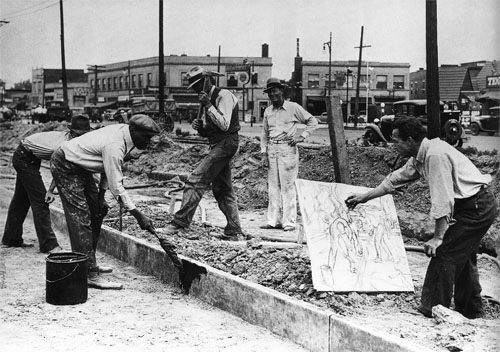 Michigan creative person Alfred Castagne sketching Works Progress Assistants (WPA) construction workers, May 19, 1939.
Michigan creative person Alfred Castagne sketching Works Progress Assistants (WPA) construction workers, May 19, 1939.
 Web Content Display
Web Content Display
FDR's New Deal provided federally-funded jobs for millions of unemployed Americans during the Groovy Depression. These included jobs for tens of thousands of artists, including musicians, actors, dancers, writers, photographers, painters, and sculptors. Asked why the government should provide jobs for unemployed artists, New Deal administrator Harry Hopkins replied, "Hell, they've got to swallow merely like other people."
Government art programs rescued artists from poverty and despair. Only they also served a larger purpose-to give all Americans admission to art and civilization. New Deal artists brought theater, music, and dance to every corner of the nation and created hundreds of thousands of paintings, prints, drawings and sculpture. Their work continues to adorn public buildings throughout the country.
 Web Content Display
Web Content Display
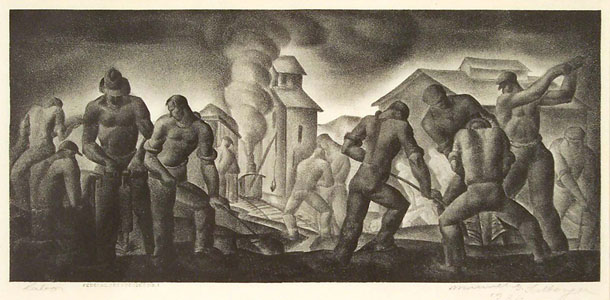 Labor; Manuel Yard. Silberger, Lithograph 1936, Federal Art Project, Works Progress Administration (WPA) MO 1956.286
Labor; Manuel Yard. Silberger, Lithograph 1936, Federal Art Project, Works Progress Administration (WPA) MO 1956.286
 Web Content Display
Web Content Display
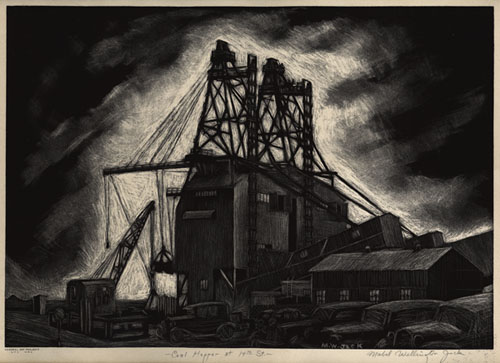 Coal Hopper at 14th Street, Mabel Wellington Jack 1937, Lithograph, New York City Federal Art Projection, Works Progress Administration (WPA), MO 1956.261
Coal Hopper at 14th Street, Mabel Wellington Jack 1937, Lithograph, New York City Federal Art Projection, Works Progress Administration (WPA), MO 1956.261
 Spider web Content Display
Spider web Content Display
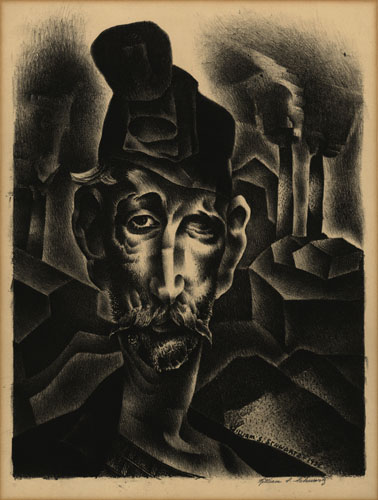 Portrait of a Miner, William South. Schwartz 1938, Lithograph, MO 1956.285
Portrait of a Miner, William South. Schwartz 1938, Lithograph, MO 1956.285
 Web Content Display
Web Content Display
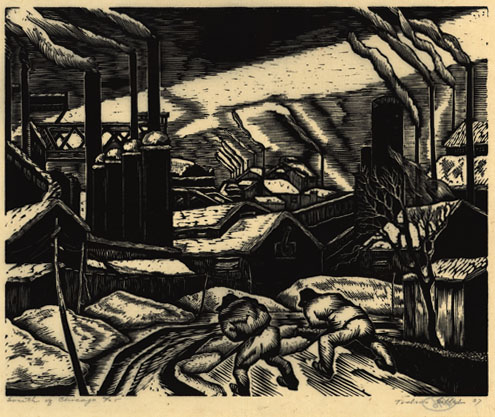 South of Chicago, Todros Geller 1937, Wood engraving, Illinois Federal Art Project, Works Progress Administration (WPA), MO 1956.314
South of Chicago, Todros Geller 1937, Wood engraving, Illinois Federal Art Project, Works Progress Administration (WPA), MO 1956.314
 Spider web Content Brandish
Spider web Content Brandish
The Alphabetize of American Pattern
Ane of import art projection undertaken during the New Deal was the Index of American Blueprint (IAD). Near 400 artists were put to piece of work locating iii-dimensional examples of American design from around the nation. They made renderings of objects ranging from weather vanes and glassware to religious icons, tavern signs, quilts and furniture. In the process they amassed a rich record for future report and artistic inspiration.
The Portfolio of Castilian Colonial Design in New Mexico was a typical IAD undertaking. Artists from New Mexico crisscrossed their country searching for
"a cross section of the characteristic blazon of textile made in New Mexico during Colonial times." They so created faithful color reproductions of these artworks. Most of the images in the Portfolio are reproductions of religious folk art painted on woods panels (retablos) and three-dimensional religious icons (bultos).
Simply 200 copies of the Portfolio were produced. The FDR Library has a complete gear up, consisting of 50 manus-colored woodblock prints. Four of these prints are displayed here.
 Web Content Display
Web Content Display
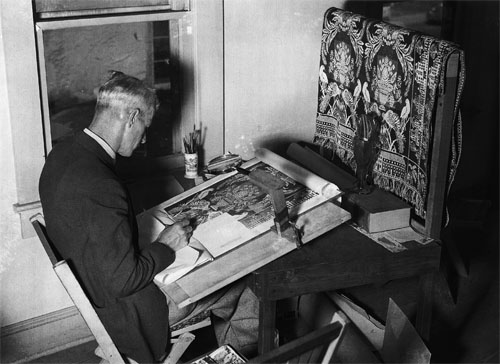 WPA artist Magnus Fossum copying the 1770 coverlet "Boston Boondocks Design" for the Index of American Design, Coral Gables, Florida, February 1940.
WPA artist Magnus Fossum copying the 1770 coverlet "Boston Boondocks Design" for the Index of American Design, Coral Gables, Florida, February 1940.
 Spider web Content Display
Spider web Content Display
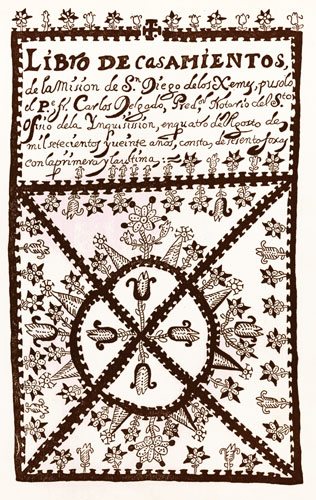 Portfolio of Spanish Colonial Design in New Mexico, Paw colored woodblock print 1938, Federal Art Project of New Mexico, Works Progress Administration (WPA), MO 1956.237.01. This reproduction depicts the title page of the book of marriages at the Mission Church building in Jemez.
Portfolio of Spanish Colonial Design in New Mexico, Paw colored woodblock print 1938, Federal Art Project of New Mexico, Works Progress Administration (WPA), MO 1956.237.01. This reproduction depicts the title page of the book of marriages at the Mission Church building in Jemez.
 Spider web Content Brandish
Spider web Content Brandish
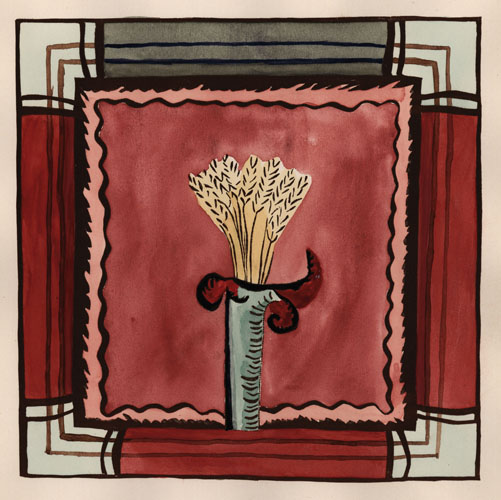 Portfolio of Spanish Colonial Design in New United mexican states, Hand colored woodblock print 1938, Federal Art Projection of New Mexico, Works Progress Administration (WPA), MO 1956.237.16. Reproduction of a panel form in Chimayo's El Santuario Church.
Portfolio of Spanish Colonial Design in New United mexican states, Hand colored woodblock print 1938, Federal Art Projection of New Mexico, Works Progress Administration (WPA), MO 1956.237.16. Reproduction of a panel form in Chimayo's El Santuario Church.
 Web Content Brandish
Web Content Brandish
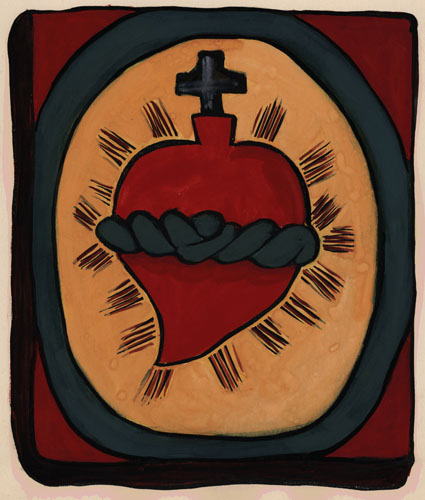 Portfolio of Spanish Colonial Design in New United mexican states, Paw colored woodblock print 1938, Federal Fine art Project of New United mexican states, Works Progress Administration (WPA), MO 1956.237.50. Reproduction of an image of the Sacred Center.
Portfolio of Spanish Colonial Design in New United mexican states, Paw colored woodblock print 1938, Federal Fine art Project of New United mexican states, Works Progress Administration (WPA), MO 1956.237.50. Reproduction of an image of the Sacred Center.
 Web Content Brandish
Web Content Brandish
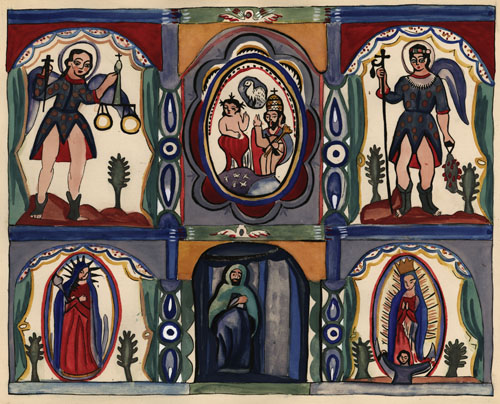 Portfolio of Spanish Colonial Design in New United mexican states, Hand colored woodblock print 1938, Federal Art Projection of New Mexico, Works Progress Administration (WPA), MO 1945.237.6. Reproduction of scenes from the lives of saints that beautify the main altarpiece of a church building in Santa Cruz.
Portfolio of Spanish Colonial Design in New United mexican states, Hand colored woodblock print 1938, Federal Art Projection of New Mexico, Works Progress Administration (WPA), MO 1945.237.6. Reproduction of scenes from the lives of saints that beautify the main altarpiece of a church building in Santa Cruz.
 Spider web Content Display
Spider web Content Display
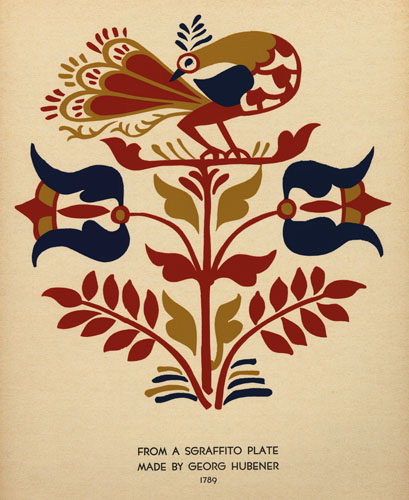 Folk Art of Rural Pennsylvania, Silkscreen print 1938, Federal Fine art Project of Pennsylvania, Works Progress Assistants (WPA), MO 1945. 236.4. One of xv prints in an Alphabetize of American Blueprint portfolio titled Folk Fine art of Rural Pennsylvania.
Folk Art of Rural Pennsylvania, Silkscreen print 1938, Federal Fine art Project of Pennsylvania, Works Progress Assistants (WPA), MO 1945. 236.4. One of xv prints in an Alphabetize of American Blueprint portfolio titled Folk Fine art of Rural Pennsylvania.
 Web Content Display
Web Content Display
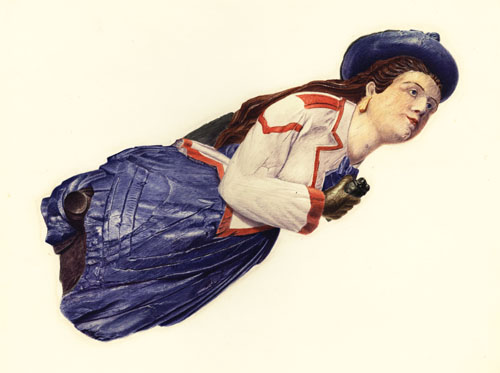 Figurehead for the Lady Blessington, Watercolor, Jerome Hoxie Tardily 1930s, Federal Fine art Project of Connecticut, Works Progress Administration (WPA), MO 1942.35.1. The Federal Art Project of Connecticut produced a series of watercolors depicting early ship carvings for the Alphabetize of American Design.
Figurehead for the Lady Blessington, Watercolor, Jerome Hoxie Tardily 1930s, Federal Fine art Project of Connecticut, Works Progress Administration (WPA), MO 1942.35.1. The Federal Art Project of Connecticut produced a series of watercolors depicting early ship carvings for the Alphabetize of American Design.
 Web Content Display
Web Content Display
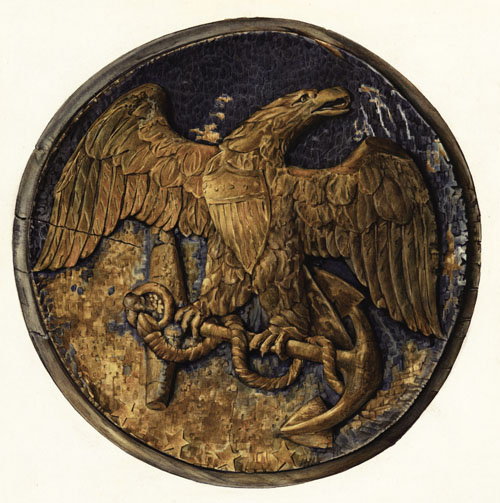 Figurehead from an unidentified transport, Watercolor, Victor Muollo Belatedly 1930s, Federal Fine art Projection of New York City, Works Progress Assistants (WPA), MO 1956.231. One of a series of watercolors of early ship carvings produced past the Federal Fine art Project of Massachusetts for the Index of American Design. This carving served as an ornament for a porthole cover.
Figurehead from an unidentified transport, Watercolor, Victor Muollo Belatedly 1930s, Federal Fine art Projection of New York City, Works Progress Assistants (WPA), MO 1956.231. One of a series of watercolors of early ship carvings produced past the Federal Fine art Project of Massachusetts for the Index of American Design. This carving served as an ornament for a porthole cover.
 Web Content Display
Web Content Display
New Bargain Murals
Ane of the most indelible creative legacies of the New Deal are hundreds of colorful murals that adorn post offices, libraries, public schools, and other regime buildings around the nation.
One example can exist found in the anteroom of the Hyde Park Post Function, located on Route 9, ii miles north of the FDR Library. The mural depicts scenes from the history of this area. It was created by Dutchess County artist, Olin Dows. Dows was a friend and neighbor of Franklin Roosevelt and the President took an active interest in the landscape'south pattern. The Library has an all-encompassing collection of Dows' study sketches, drawings, and paintings for this mural and another landscape he made for the Rhinebeck Mail Function. The drove documents every stage in the design process. This console features several samples from the Dows collection that focus on i section of the Hyde Park Post Part mural.
 Web Content Display
Web Content Display
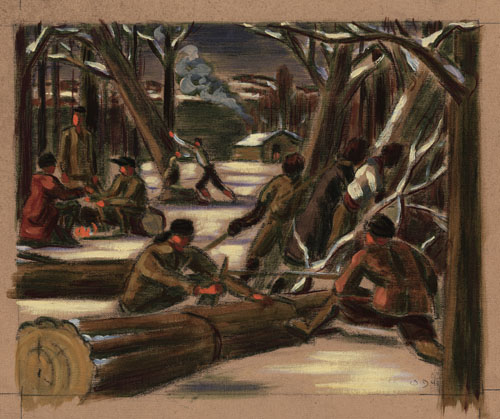 Last color report, Stoutenburgh console, Olin Dows .1941, Department of Fine Arts, Treasury Department, MO 1968.15.1
Last color report, Stoutenburgh console, Olin Dows .1941, Department of Fine Arts, Treasury Department, MO 1968.15.1
 Web Content Display
Web Content Display
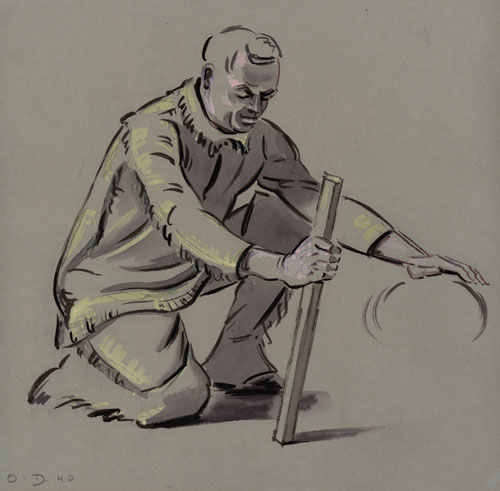 Mixed media drawing for Stoutenburgh panel, Olin Dows 1941, Section of Fine Arts, Treasury Department, MO 1968.fifteen.17. An early on sketch of the figure that appears in the foreground of the final color report above.
Mixed media drawing for Stoutenburgh panel, Olin Dows 1941, Section of Fine Arts, Treasury Department, MO 1968.fifteen.17. An early on sketch of the figure that appears in the foreground of the final color report above.
 Web Content Display
Web Content Display
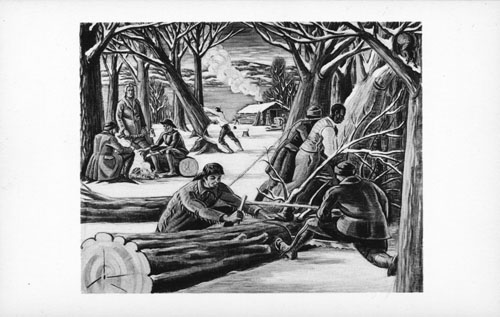 Postcard depicting Stoutenburgh panel, ca. 1940s, MO 1968.15.15. This postcard features a black and white epitome of the Stoutenburgh console as it appears (in colour) in the anteroom of the Hyde Park Post Office.
Postcard depicting Stoutenburgh panel, ca. 1940s, MO 1968.15.15. This postcard features a black and white epitome of the Stoutenburgh console as it appears (in colour) in the anteroom of the Hyde Park Post Office.
trouettedentoory64.blogspot.com
Source: https://www.fdrlibrary.org/art-detail